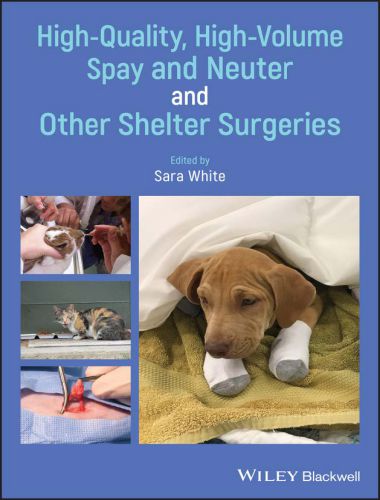High-Quality, High-Volume Spay and Neuter and Other Shelter Surgeries, Why do we need a spay and neuter textbook? Spaying and neutering are often the first (and in some cases, the only) surgeries that students learn in veterinary school, and are expected skills for every new graduate in general small‐ or mixed‐animal practice.
High-Quality, High-Volume Spay and Neuter and Other Shelter Surgeries

It can be tempting to dismiss them as “beginner surgeries,” the easily trivialized but sometimes terrifying rites of passage into the veterinary profession. Perhaps because spaying and neutering are skills learned so early and repeated so often in a general practitioner’s veterinary career, they are rarely the subject of continuing education seminars and articles, and general practitioners may go their entire career without modifying or even questioning the techniques for spaying and neutering that they learned as third‐year veterinary students.
At the same time, spaying and neutering have been central to efforts to reduce the over-population and euthanasia of unwanted and unowned cats and dogs. The spay–neuter clinics and programs that have arisen over the past several decades recognized the need for minimally invasive, efficient techniques that would shorten surgical times and improve patient recovery. This textbook pulls together many of the surgical, anesthetic, peri‐operative, and operational techniques discovered, developed, and popularized over the decades by these innovative spay–neuter pioneers.
Download More: Laser Surgery in Veterinary Medicine
High‐quality, high‐volume spay–neuter (or HQHVSN, the awkward but now widely used acronym adopted by the first Spay Neuter Task Force) is the field of veterinary medicine that began with the efforts of spay–neuter pioneers in the 1970s through the 1990s, and became firmly established and advanced by the publication of the 2008 and 2016 spay–neuter guidelines. HQHVSN is defined as “efficient surgical initiatives that meet or exceed veterinary medical standards of care in providing accessible, targeted sterilization of large numbers of cats and dogs to reduce their overpopulation and subsequent euthanasia” (Griffin etal. 2016).
Part One concludes with a section on other common shelter surgeries and associated anesthetic procedures, and can serve as a reference for shelter surgeons with a variety of levels of experience. This section includes amputations, eye surgeries, vulvar or rectal prolapse treatment, and dental extractions.
Part Two of this book moves away from the clinical care of individual patients and into the structures and systems fundamental to HQHVSN, with sections on population medicine, human resources and well being, and HQHVSN program models. Optimizing the potential of HQHVSN requires more than just proficiency in the clinical care (anesthesia and surgery) of individual patients. Effective HQHVSN programs must understand the effects of their interventions on animal populations and individuals; they must combine their clinical skills with appropriate staffing and facilities to allow an efficient and stream-lined workflow; they must institute systems that are financially, physically, and emotion-ally sustainable. Chapter 23 serves as an introduction and road map to the second half of this book. The material here should be of interest to anyone seeking to establish a new HQHVSN program or improve an existing one.
| PDF Size: 18 MB | Book Download Free |
Password: pdflibrary.net
